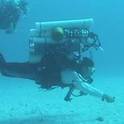
Measurements of the absorption coefficient of chromophoric dissolved organic matter (ay) are needed to validate existing ocean-color algorithms. In the surface open ocean, these measurements are challenging because of low ay values. Yet, existing global datasets demonstrate that ay could contribute between 30% to 50% of the total absorption budget in the 400-450 nm spectral range, thus making accurate measurement of ay essential to constrain these uncertainties. In this study, we present a simple way of determining ay using a commercially-available in-situ spectrophotometer operated in underway mode. The obtained ay values were validated using independent collocated measurements. The method is simple to implement, can provide measurements with very high spatio-temporal resolution, and has an accuracy of about 0.0004 m−1 and a precision of about 0.0025 m−1 when compared to independent data (at 440 nm). The only limitation for using this method at sea is that it relies on the availability of relatively large volumes of ultrapure water. Despite this limitation, the method can deliver the ay data needed for validating and assessing uncertainties in ocean-colour algorithms.
Available at: http://works.bepress.com/emmanuel_boss/42/
